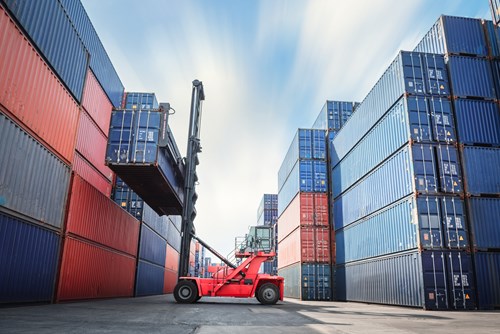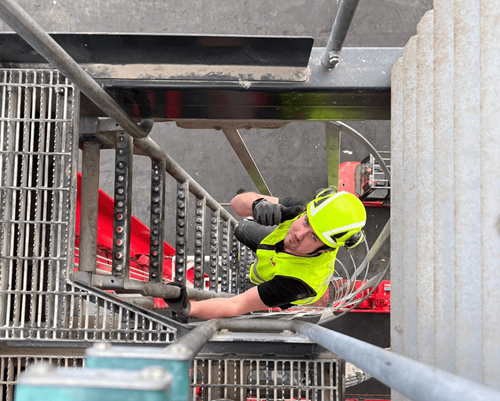Keeping up with the port industry’s evolving fire risks

The international shipping and materials handling industries continue to grow rapidly, due to new ports and terminals being built globally. This is seeing operations and vehicle technology evolve quickly, meaning that understanding the new fire risks associated with this is essential, now more than ever.
Below, we discuss the escalating fire risks associated with the industry’s technological development and explore how understanding these risks can help to reduce costs, minimise downtime and protect lives.
With 90% of global trade currently being transported via ocean shipping, protecting material handling at ports has never been so important. As the number of containers shipped per year is estimated at over 200 million, minimising downtime is essential to increase efficiency and meet tight deadlines.
However, as vehicle technology at ports evolves, fire risks become more apparent. If these risks are not controlled, they have the potential to cause increased downtime and possibly the suspension of transportation of certain goods. For example, the Port of Shanghai, the busiest container port in the world, was recently suspended from transporting high-risk goods for two weeks by the Shanghai authorities following a fire, which affected supply chains and profits.
An evolving industry
During the coronavirus pandemic, the international shipping industry continued to operate. However, keeping on-site workers protected from COVID-19 became an urgent priority – which influenced the quick adoption of automated vehicles. This modern technology allowed a large percentage of the workforce to work from home or at remote workstations, allowing operations to continue whilst protecting workers from COVID-19.
The world has since returned to work, but automated vehicles in ports are here to stay – with a combination of automated cranes and automated port vehicles now commonly used at many ports. However, maximising uptime is a key priority when working to tight schedules, so understanding this new technology to address its associated risks is vital.
Against this autonomous backdrop is the global electrification of vehicles and machinery, with many port operators shifting from traditional combustion engines to modern hybrid, as well as fully electric motors.

Recognising rising risks
Although these developments are advancing the sector, it’s also important to consider the new risks caused by electrification and automation to maintain high safety standards whilst minimising downtime.
Whenever a new technology is introduced to your operations, the risks of your site will change, meaning you first need to gain an understanding of these.
Introducing autonomous and electric vehicles can potentially create a variety of risks, including:
-
Reduced workers on site
As the number of autonomous vehicles on site increases, so does the number of drivers in remote workspaces, meaning there will be fewer staff on site at any given time. This increases fire risks, as there are less people to manually detect an occurring fire, for example, by seeing or smelling smoke.
This can then cause significant delays in the activation of manual fire suppression systems, aggravating damage and safety risks. Although drivers may be able to activate the system remotely, it’s important to acknowledge that there will still be a delay in system activation, as the vehicle will need to communicate with the operator, who will then communicate back to the vehicle to activate the suitable suppression technique.
This increased response time can mean a fire is more likely to happen, causing greater safety risks, more extensive vehicle damage and the increasing likelihood of operational downtime.
-
Increased number of li-ion batteries
The worldwide shift to electric vehicles has caused an increased number of lithium-ion (Li-ion) batteries in ports and other high-risk environments. These batteries are rechargeable, where lithium ions move between negative and positive electrodes to generate sustainable energy.
Although these batteries offer a much more sustainable energy source, they also cause new fire risks. Due to the large amount of energy stored in li-ion batteries, increased heat, mechanical failure, overcharging, or physical damage can cause an internal short circuit, which can then lead to a process called thermal runaway.
Thermal runaway is an extremely dangerous state, which can lead to toxic gas emissions and large explosions, if not controlled quickly. In this state, a battery can also generate its own source of oxygen, reducing the effectiveness of traditional suppression techniques.

Protecting operations
As the material handling industry evolves and risks change, protecting your site to ensure maximum safety and minimal downtime is vital. To fully understand your site, you can use the following steps:
-
Update your risk assessment map
Before considering how you may change your fire suppression systems, you should first produce a risk assessment map. This will include sources of fire, routes for an emergency, where current firefighting equipment is kept and how emergency services will enter your site.
Although it’s likely your site will already have one of these maps, it’s important to update this when you acquire new equipment or machinery. This will help you to recognise specific areas of risk and consider how you can make these areas safer.
-
Choose your equipment
If you’re protecting new autonomous vehicles, automatic detection and activation are essential to ensure fires are controlled quickly and safely. It’s also important to ensure the system you choose is an appropriate match for the vehicle it’s being used on to minimise false activations and unnecessary downtime.
If you’re protecting electric vehicles, it’s important to acknowledge the battery chemistry so you’re aware of the potential risks and the necessary fire suppression system to address these. For example, the Research Institutes of Sweden (RISE) and Dafo Vehicle Fire Protection discovered that an early fire warning system and spot cooling are most effective for preventing a li-ion battery from reaching thermal runaway.
-
Consider your site as a whole
Protecting new technology is important, but you shouldn’t disregard your older, traditional combustion vehicles. These risks are different but still need to be addressed in your fire protection solution, as they can also cause extended downtime if a fire occurs, affecting schedules and profit margins.
Installing fire detection and suppression equipment is the first step to increasing the safety of your site. To ensure it’s effective, take the time to train your workers – those working on site and remotely – in how to react to an autonomous vehicle fire, an electric vehicle fire and a traditional combustion engine fire. This will ensure their personal safety and the safety of the site and its equipment.
As the port industry continues to evolve quickly, it’s important to fully understand the fire risks caused by new technology to ensure site operations can operate effectively, with maximum safety and minimal downtime.
For more information on protecting your material handling fleet, get in touch.
 ;
;
 ;
;